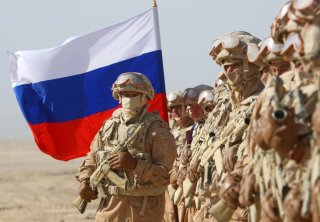Can Central Asia Help Russia Cajole the Taliban?
Though hundreds of miles distant, Russia’s military strength and connection to Afghanistan through Central Asia suggest a powerful role in Afghanistan’s future affairs.
Thirty years after the last Soviet tank left Afghanistan, the Kremlin is openly exploiting the power vacuum caused by the abrupt U.S. departure. Though Russia is cooperating with the Taliban and other regional powers in Afghanistan, it is so far keeping them at arm’s length.
Russia’s renewed interest in Afghanistan comes in several forms. The potential for instability to spread into the post-Soviet Central Asian states and into Russia itself is an obvious concern. As in Syria, the Kremlin is keen to prevent a breeding ground fostering ISIS and Islamic extremism. The prospect of a sharp rise in drug trafficking and a refugee crisis has also made the issue of Afghanistan’s border security paramount to Russia’s.
Beyond that, Afghanistan’s plentiful natural resources have always had considerate appeal. While Russia no doubt wishes to exploit such reserves, it also wants to prevent Afghanistan from emerging as a resource powerhouse that could undermine revenue streams for Russian energy companies. A stronger influence over Afghanistan would also give the Kremlin significant geopolitical leverage at the crossroads of China, the Indian subcontinent, and the Middle East.
To achieve its goals, the Kremlin has sought growing engagement with the Taliban. Their relationship is driven by pragmatism and seeks to brush aside their former animosity. Many in the Taliban’s ranks can trace their history back to the Mujahideen forces that drove out the Soviet military from Afghanistan three decades ago. In the 1990s, the Taliban also supported Russia’s separatist Chechen forces and declared jihad against Russia in solidarity; In 2003 Russia officially labeled the Taliban a terrorist organization.
However, as tensions between the United States and Russia worsened after the 2014 Ukraine crisis and Syrian Civil War, the Kremlin greatly increased its dialogue with the Taliban. Since 2018, Taliban representatives have been visiting Moscow for talks in preparation for the U.S. exit from Afghanistan. As the chaos left behind unfolded, the Russian embassy in Kabul remained open, having received direct assurance from the Taliban that it would not be targeted. While Moscow has not officially recognized the Taliban as the legitimate governing authority of Afghanistan, its cautious approach has maintained that possibility.
Taliban officials, wary of international isolation, have committed to outreach with not only Russia but several other regional powers that border Afghanistan. China, Iran, and Pakistan have their own overlapping strategic interests in Afghanistan, and while Russia has publicly stated its intention to cooperate with them, it will be competing for influence in the country. China’s attempts to create a direct land route to the resource-rich Middle East through Afghanistan to Iran, for example, would significantly undercut Russia’s position as Beijing’s top supplier of oil and natural gas.
Because it does not border Afghanistan, the key to Russia’s strategy will be utilizing its influence in the post-Soviet Central Asian states. In Tajikistan, which neighbors Afghanistan, roughly 6,500 Russian troops have remained in place since the Soviet collapse at the Russian 201st Military Base. Scheduled to remain until at least 2042, the Russian military presence has both kept Tajikistan stable following the conclusion of its civil war in 1997 and helped project Russian military power deep into Central Asia.
As U.S. forces withdrew from Afghanistan this month, Russian, Tajik, and Uzbek troops held war games on the Tajik-Afghan border as a show of force. Alongside Kyrgyzstan and Kazakhstan (as well as Armenia and Belarus), Tajikistan belongs to the Russian-led Collective Security Treaty Organization (CSTO) military alliance. The display was intended to prove Russia’s intention to play a pivotal role in subduing any security threats emanating from Afghanistan.
Russia has said it will not put troops in Afghanistan—a view influenced by its previous disastrous experience. But it has also said the same about Ukraine. Instead, private military companies, militants, and special forces have helped maintain conflict there. So, while a Soviet-style invasion is off the table, Russia’s destabilization of Ukraine and stabilization of Syrian president Bashir al-Assad are evidence of Russia’s growing ability to manipulate conflict.
Despite the rapid fall of U.S.-trained Afghan forces, parts of the country are showing pockets of resistance to the Taliban—particularly in its Tajik-heavy north. Any Russian efforts to protect ethnic Tajiks or Russian citizens in this region would draw on similar justifications used in the 2008 Russia-Georgia War; this time potentially aided by a multinational force. Russia’s naval dominance in the Caspian Sea and its ability to strike Afghanistan from its waters have also increased its military edge in the land-locked country. Afghan instability could also influence Uzbekistan to rejoin the CSTO alliance after it left in 2012.
Though hundreds of miles distant, Russia’s military strength and connection to Afghanistan through Central Asia suggest a powerful role in Afghanistan’s future affairs. But the Kremlin’s ambitions will be complicated by China’s economic power, Iranian and Pakistani cultural influence, and the entrenched presence of the Taliban.
And if Russia’s Afghan strategy falters, its regional rivals will naturally look towards Central Asia—this time without the distraction of their common U.S. adversary.
John Ruehl is a contributing editor at Strategic Policy, a foreign affairs magazine based in DC.
Image: Reuters.

